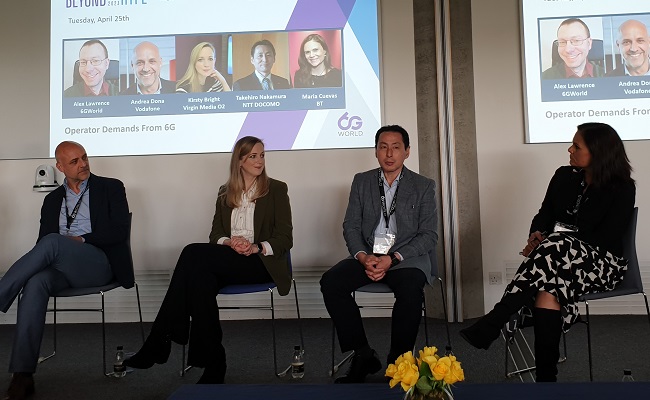[ad_1]

LIVE FROM 6G SYMPOSIUM, 6G INNOVATION CENTRE, GUILDFORD, UK: A panel of operators wrestled with issues around the shape of 6G, questioning the viability of mass network hardware changes every decade and raising the prospect the next generation may enhance 5G rather than replacing it.
During the session, representatives from UK operators Virgin Media O2, BT and Vodafone UK were joined by Japanese player NTT Docomo to outline their ambitions for 6G, with a number citing the need to derive value from 5G investments and deliver on that promise first.
Vodafone UK chief network officer Andrea Dona (pictured, far left) said the new generation “cannot be yet another hardware replacement programme” after a string of rip-and-replace cycles. “It needs to be an intelligent software overlay that really brings the full potential of 5G.”
He added 5G had been devised as “completely future-proof service-based architecture” which had not yet been brought fully to life.
BT Applied Research networks research director Maria Cuevas (pictured, far right) indicated the ten-year cycle between mobile technology generations and chasing “artificial KPIs” around the network were not economically sustainable, highlighting a need for an overarching vision for the next generation.
Smooth transitions
Agreeing with the comments around generational jumps, Virgin Media O2 director of network innovation and transformation Kirsty Bright (pictured, left of centre) endorsed a “smooth transition” between generations with networks taking an evolutionary path rather than a decade-long cycle.
“It is time to stop talking about 5G, 6G, 7G, because if you remember what happened with 5G from a consumer perspective there was a lot of expectation and a lot of pressure on operators”, noting they had been unable to charge more for the new service.
Part of the issue raised by Cuevas in the business segment was a fear industries may see the usual decade-long replacement cycle for the generations as a reason to delay investments in the late 2020s in an expectation 6G was imminent.
NTT Docomo chief technology architect Takehiro Nakamura (pictured, right of centre) said although he was still struggling with what the “big gain” use case of the new technology will be, he hoped there will be one.
He added there is “still time to develop” use cases to justify the outlay.
While seemingly wanting a different type of generational shift, the panel did note potential advantages of 6G around improving coverage and delivering on the promise of previous generations.
Within this, a potential shaping of the new technology highlighted was the possibility for 6G to deliver a so-called network of networks, improving reliability for end users and providing truly ubiquitous coverage.
[ad_2]
